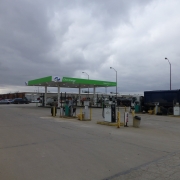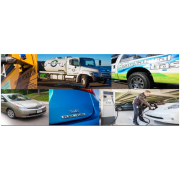Happy Cab rolls around with MUD, flashes smile at CNG
Happy Cab rolls around with MUD, flashes smile at CNG
By Jerry LaMartina
Metropolitan Energy Center, freelance writer
A few years ago, Happy Cab Co. of Omaha, Neb., joined forces with the Metropolitan Utilities District of Omaha (MUD). Their goal: Develop a market for natural gas vehicles (NGVs) in the Midwest.
They made it, with help from part of a $15 million U.S. Department of Energy (DOE) Clean Cities grant awarded in December 2009. The grant also benefited several other municipalities, companies and others in the Kansas City area and elsewhere that had implemented alternative-fuels projects.
Kansas City-based Metropolitan Energy Center (MEC) administered the entire grant through a contract with the DOE. All the projects supported by the grant constitute MEC’s Midwest Region Alternative Fuels Project.
Happy Cab received $593,000 from the grant and matched that from its own pocket for the project, whose total cost was nearly $1.2 million. The cab company trained its technicians in compressed natural gas (CNG) vehicle conversion to minimize labor costs and reduce overhead for the project. Their technicians then installed dedicated CNG kits – certified by the Environmental Protection Agency – on 54 Chevrolet Impalas and one Ford F550 flatbed tow truck and rescue fill vehicle that can do roadside, fast-fill refueling. Happy Cab put the Impalas into service in its taxi cab fleet in an effort to maximize the volume of gasoline that the CNG would displace.
And the company partnered with MUD to open a public CNG fast-fill fuel station in Omaha in
June 2011 at a former gas station owned by Happy Cab’s sister company, I-80 Fuel, at 5318 L St. MUD designed that station and another in Omaha with public access, at 63rd Avenue and Center Street.
John Davis, Happy Cab’s director of operations, says the project has displaced 75,000 gallons of gasoline a year since it went into service. That’s easy to like from an environmental perspective, and the company’s technicians and drivers also like the CNG-fueled vehicles because the technology was new to them, Davis says.
“Through the implementation of this NGV program, the techs have learned how to troubleshoot CNG-related issues and in some cases make recommendations for best practices that can and will improve reliability, performance or both,” he says.
The technicians and drivers think the vehicles are very comparable to gasoline models, Davis says. The only difference is the fuel and its delivery system.
“The big difference is being limited on refueling infrastructure,” he says. “There is a gasoline station on almost every corner. However, the drivers have to plan out refueling times for CNG. When comparing CNG with diesel on medium- or heavy-duty trucks, CNG is a cleaner-burning fuel, so it doesn’t create the heavy black exhaust gases or the distinctive smell that diesel leaves behind. The CNG engines are also so much quieter, so much so that when CNG garbage trucks go into service there have been reports of customers calling and saying they missed their pickup because they no longer hear the garbage truck coming down the block.”
Fleet managers like the alternative-fuel vehicles, too, Davis says, in part because CNG is about half the cost of diesel per gas gallon equivalent (gge). Medium- and heavy-duty trucks typically get eight to 10 miles per gallon, so the return on investment for them typically is greater compared with gasoline-fueled automobiles.
Because alternative-fuel vehicles and fueling stations do require an investment of money, Davis advises those who are considering it to start by doing their due diligence.
“I would recommend that the fleet manager seek out a fleet utilizing NGVs that are comparable to their own,” he says. “They need to know how many miles their vehicles average each week. They need to consider how long their vehicle may sit and idle at a job site and what type of fueling infrastructure they have in their service area.”
This due diligence from a financial and practical perspective pays off environmentally, as well.
“For a number of reasons, we need to do our part to lower our carbon footprint in our community,” Davis says. “This project was the right thing to do environmentally, and it made sense from a business perspective when leveraging the matching funds because it made the ROI attainable in four years.”
*************************************
Lamartina.jerry@gmail.com





